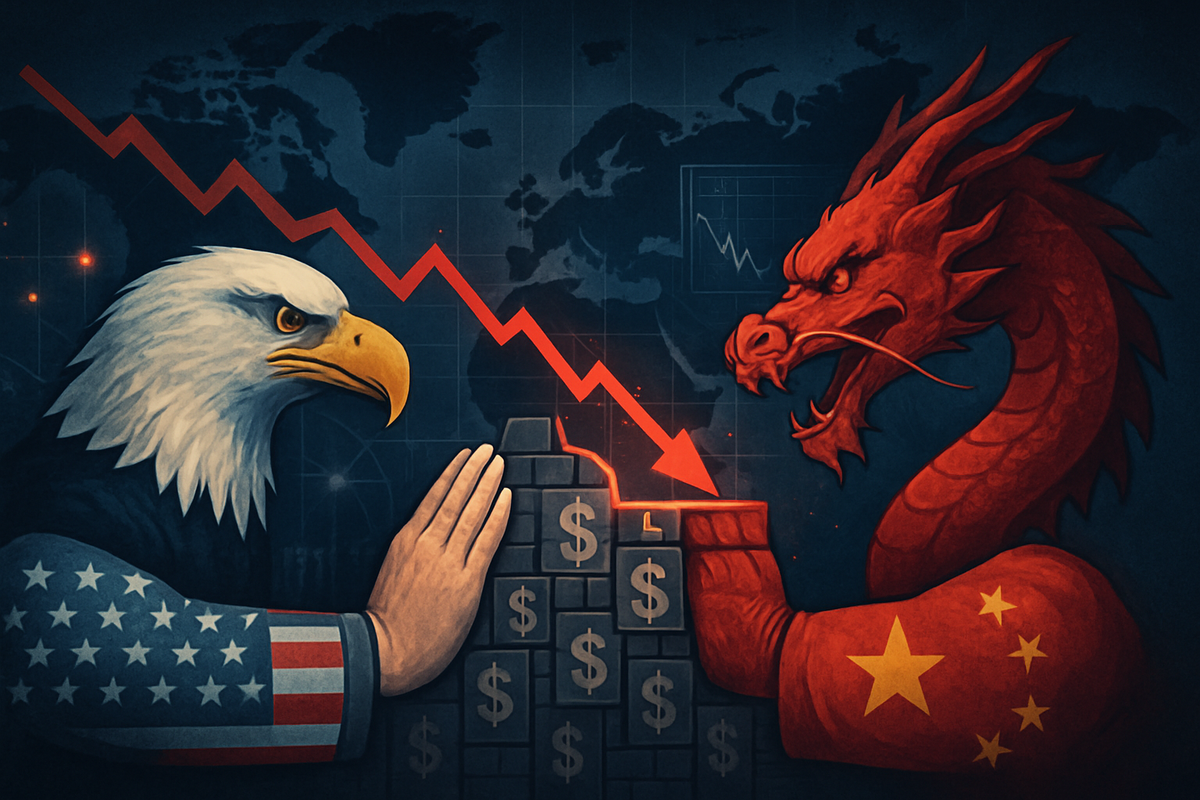
October 10, 2025 - Global financial markets are once again reeling today as former President Donald Trump issued fresh threats of a "massive increase of Tariffs on Chinese products" entering the United States. The pronouncement, made via his Truth Social platform, accuses Beijing of "very hostile" moves to restrict exports of critical rare earth elements, immediately sending shockwaves through stock exchanges worldwide and signaling a dangerous escalation in the protracted US-China trade dispute. This latest development underscores a year of intensifying trade friction, leaving investors and industries grappling with profound uncertainty and the specter of a full-blown economic confrontation.
The immediate implications are stark: market indices plunged, key technology stocks tumbled, and commodity prices saw significant shifts. This isn't an isolated incident but the latest chapter in a year-long saga of escalating tariffs and retaliatory measures, indicating that the trade war remains a dynamic and unresolved situation with far-reaching consequences for global trade and financial stability.
A Year of Escalation: Trump's Tariff Offensive Deepens
The current market turmoil on October 10, 2025, stems directly from President Trump's explicit threat to impose significantly higher tariffs on Chinese imports. His statement specifically cited China's alleged "hostile" actions in restricting rare earth elements, vital components for numerous American industries, from electronics to defense. In a further move designed to ratchet up pressure, Trump also announced the cancellation of a planned meeting with Chinese President Xi Jinping at an upcoming APEC summit in South Korea, declaring there was "no reason to do so."
This latest threat is the culmination of a year marked by aggressive trade policies under the Trump administration. The year 2025 began with the implementation of a 10% additional tariff on Chinese imports on February 4, swiftly followed by an increase to 20% on March 4. April saw the introduction of "Liberation Day" tariffs on April 2, a sweeping policy that imposed a universal 10% tariff on almost all US imports from April 5. Throughout the spring and summer, US tariffs on Chinese goods repeatedly escalated, reaching a staggering 145% by August 7, 2025.
China, in turn, retaliated with its own tariffs on US exports, reaching 125%.
The key players in this high-stakes economic drama are primarily the United States, led by President Trump, and China, under President Xi Jinping. Their confrontational stances have dictated the pace and intensity of the trade war, with global businesses and consumers caught in the crossfire.
The initial market reaction to today's threats has been overwhelmingly negative. U.S. stock indexes plunged, with the S&P 500 declining 1.8% and the Nasdaq 100 falling 2.4% by early afternoon. The Dow Jones Industrial Average (NYSE: ^DJI) shed 480 points (1.05%). Technology giants like Nvidia (NASDAQ: NVDA), Broadcom (NASDAQ: AVGO), Tesla (NASDAQ: TSLA), and AMD (NASDAQ: AMD) experienced significant declines, reflecting their deep integration into global supply chains and reliance on Chinese markets. Overseas, Japan's Nikkei 225 Index (TYO: ^N225) slumped 1.0%, Hong Kong's Hang Seng Index (HKG: ^HSI) tumbled 1.7%, and major European markets including the UK's FTSE 100 (LSE: ^FTSE), Germany's DAX Index (ETR: ^GDAXI), and France's CAC 40 Index (EPA: ^FCHI) all moved to the downside. Commodity markets also felt the sting, with copper plummeting 4.9% on the London Metal Exchange (LME). In a notable counter-trend, US-based rare earth stocks, such as MP Materials (NYSE: MP) and USA Rare Earth, surged 11% and 15% respectively, as investors sought domestic alternatives amidst concerns over China's export controls. Bond markets saw treasuries surge, and the yield on the benchmark ten-year note fell by 8.3 basis points, indicating a flight to safety.
Corporate Fortunes in the Crosshairs: Winners and Losers
The escalating trade war between the US and China, fueled by Trump's renewed tariff threats, is creating a clear divide between potential corporate winners and losers. Companies deeply integrated into global supply chains, particularly those reliant on Chinese manufacturing or with significant market exposure in China, are bracing for substantial headwinds. Conversely, domestic manufacturers and those involved in strategic sectors like rare earth elements stand to gain.
On the losing side are a vast array of companies, especially those in the technology, automotive, and consumer goods sectors. Many US-based multinationals, such as Apple (NASDAQ: AAPL), which heavily relies on Chinese factories for iPhone assembly, face increased production costs and potential supply chain disruptions. Similarly, automakers like General Motors (NYSE: GM) and Ford (NYSE: F), with substantial sales and manufacturing operations in China, could see reduced demand and profitability due to retaliatory tariffs and a weakened Chinese economy. Retailers like Walmart (NYSE: WMT) and Target (NYSE: TGT), sourcing a large percentage of their merchandise from China, will likely face higher import costs, which they may either absorb, impacting margins, or pass on to consumers, potentially dampening demand. Chinese export-oriented companies, already struggling under existing tariffs, will find it even harder to compete in the US market, leading to reduced revenues and potential job losses. The semiconductor industry, with its intricate global supply chain, is particularly vulnerable, as seen with the declines in Nvidia (NASDAQ: NVDA) and AMD (NASDAQ: AMD) stock prices, as tariffs disrupt the flow of components and finished products.
Conversely, a select group of companies is poised to benefit from the trade tensions. US domestic manufacturers, particularly those in industries that compete directly with Chinese imports, could see increased demand as tariffs make foreign goods more expensive. This might encourage "reshoring" of manufacturing jobs and investment within the United States. Most notably, companies involved in the extraction and processing of rare earth elements within the US, such as MP Materials (NYSE: MP) and USA Rare Earth, are experiencing a surge in investor interest and stock prices. As China threatens to restrict rare earth exports, these domestic suppliers become strategically critical, offering a more secure supply chain for essential industrial components. Furthermore, companies that have already diversified their supply chains away from China or possess strong intellectual property that cannot be easily replicated could prove more resilient. Certain agricultural sectors in countries not involved in the trade war might also see increased demand if US and Chinese agricultural trade is significantly disrupted.
The impact on these companies will manifest in various ways: fluctuating stock prices reflecting investor sentiment and perceived risk, direct hits to revenue and profit margins due to tariffs and retaliatory measures, and significant pressure to re-evaluate and reconfigure complex global supply chains. The long-term effects could include a fundamental restructuring of global manufacturing and trade flows, favoring regionalized production and greater national self-sufficiency in critical goods.
Broader Implications: A Shifting Global Economic Landscape
Trump's renewed tariff threats are not merely an isolated incident but a significant acceleration of broader industry trends towards economic nationalism and de-globalization. This event fits squarely within a multi-year pattern of US-China strategic competition, extending beyond trade to technology, intellectual property, and geopolitical influence. The aggressive use of tariffs as a foreign policy tool signals a deeper commitment to decoupling the two largest economies, with profound implications for global commerce.
The ripple effects of this escalation are likely to be far-reaching, impacting competitors and partners across the globe. Countries heavily reliant on either the US or Chinese markets for their exports, such as Germany, Japan, and South Korea, could see their economic growth curtailed. Global supply chains, already strained by recent geopolitical events and the pandemic, will face further pressure to diversify away from China, leading to higher costs and potential inefficiencies in the short term. Multilateral trade organizations like the World Trade Organization (WTO) will find their authority further undermined as nations increasingly resort to unilateral trade actions, potentially leading to a more fragmented and less predictable global trading system.
From a regulatory and policy perspective, these tariffs challenge established international trade norms. China is likely to respond with further retaliatory tariffs, creating a tit-for-tat cycle that harms businesses and consumers in both countries. Furthermore, the focus on rare earth elements could prompt other nations to reassess their own strategic dependencies and potentially invest in domestic extraction and processing capabilities, leading to a global scramble for critical resources.
Historically, trade wars have rarely produced clear winners and often result in widespread economic damage. Comparisons can be drawn to the Smoot-Hawley Tariff Act of 1930, which exacerbated the Great Depression by significantly reducing international trade. While the current global economic structure is vastly different, the underlying principle remains: protectionism can lead to reduced economic efficiency, higher consumer prices, and slower global growth. This event underscores a dangerous return to an era where trade is weaponized, potentially unraveling decades of progress in fostering interconnected global economies.
The Path Forward: Uncertainty and Strategic Adaptation
The immediate future following Trump's latest tariff threats is shrouded in uncertainty, with both short-term volatility and long-term strategic shifts on the horizon. In the short term, markets are likely to remain highly volatile, reacting sharply to every statement from Washington or Beijing. Investors should anticipate continued downward pressure on stocks tied to global trade and technology, while "safe haven" assets like government bonds and domestic-focused industries may see increased demand. The possibility of further escalation, including additional tariffs or non-tariff barriers, remains high, as does the potential for retaliatory measures from China.
Looking further ahead, companies will be forced to make significant strategic pivots and adaptations. Supply chain resilience will become paramount, driving efforts to diversify sourcing away from China and potentially encouraging reshoring or nearshoring of manufacturing. This could lead to substantial capital expenditures in new production facilities and a re-evaluation of global operational footprints. Market opportunities may emerge for countries and companies that can offer alternative manufacturing bases or secure supplies of critical materials. For instance, nations in Southeast Asia or Latin America might see increased foreign direct investment as companies seek to de-risk their operations.
Several potential scenarios could unfold. A full-blown trade war, characterized by progressively higher tariffs and extensive non-tariff barriers, would likely lead to a significant slowdown in global economic growth, increased inflation, and reduced corporate profitability. Alternatively, a period of prolonged uncertainty, with intermittent threats and negotiations, could create a "new normal" of elevated risk, forcing businesses to operate with greater agility and contingency planning. A less likely but still possible outcome is a negotiated settlement, perhaps after a period of intense pressure, though the current rhetoric suggests such a resolution is not imminent.
The implications of these scenarios are profound. Businesses must develop robust risk management strategies, including hedging against currency fluctuations and diversifying their customer bases. Governments may also need to consider new industrial policies to support domestic industries and secure critical supply chains.
Navigating the New Normal: Key Takeaways and Investor Watchpoints
Donald Trump's latest threats of massive tariffs on China represent a critical juncture in the ongoing US-China trade war, cementing it as an escalating and enduring challenge rather than a transient phase. The immediate plunge in global stock markets, coupled with the surge in US rare earth stocks, underscores the profound and immediate impact of these protectionist policies on investor sentiment and corporate valuations. The key takeaway is clear: the era of seamless global supply chains and unrestricted trade between the world's two largest economies is under severe threat, forcing a fundamental reassessment of business models and investment strategies.
Moving forward, the market will operate in an environment of heightened geopolitical risk and economic nationalism. This "new normal" will reward companies with diversified supply chains, strong domestic market positions, and those operating in strategically critical sectors. Conversely, companies heavily reliant on Chinese manufacturing or with significant exposure to the Chinese consumer market will face persistent headwinds. The ongoing tit-for-tat tariff exchanges are likely to lead to increased production costs, reduced profit margins, and potentially higher consumer prices.
For investors, vigilance is paramount in the coming months. Key indicators to watch include:
- Further Policy Announcements: Any new tariff implementations or retaliatory measures from either the US or China will directly influence market direction.
- Diplomatic Engagements: While a meeting between Trump and Xi has been canceled, any future diplomatic overtures or shifts in rhetoric could signal a change in trajectory.
- Economic Data: Monitoring manufacturing indices, trade balances, and inflation rates in both the US and China will provide insights into the real-world impact of these policies.
- Corporate Earnings Reports: Companies' quarterly reports will offer concrete evidence of how tariffs are affecting their revenues, costs, and profitability, particularly those with significant international operations.
- Commodity Markets: Fluctuations in commodity prices, especially for industrial metals and rare earth elements, will be a bellwether for global manufacturing health and supply chain stability.
Ultimately, the lasting impact of this escalating trade war could be a significant reordering of global trade flows, a push towards greater national economic self-sufficiency, and a more fragmented international economic system. Investors must adapt to this evolving landscape, prioritizing resilience and strategic positioning over traditional globalization-driven growth models.
This content is intended for informational purposes only and is not financial advice





